Click here to jump down to the piano scales generator
Piano scales are an important part of developing your playing skills and understanding the building blocks of music. They help enormously to understand key signatures.
If you have ever wondered why pianists play them, how they work and what the benefits are then you are in the right place. With a simple formula you will learn to play major, minor and blues scales. If you incorporate a few minutes of learning and practicing scales into your daily schedule, you’ll soon see the advantages of making time for scales.
What are piano scales?
A scale is a collection of related notes moving in a stepwise sequence, like a ladder. Each scale begins on its key note, (also called the ‘tonic’) which matches the name of the scale. For instance, if you are going to play an A major scale, you’ll begin on the note A. If you’re going to play an F minor scale, you’ll begin on the note F.
If the notes in a song can be found in a D major scale, then the piece is said to be in the ‘key of D major’. Scales are usually played ascending (going up) then descending (going down). The main way piano scales differ from scales on other instruments is that you can play them with both your hands at the same time!
Here is a great lesson on Skoove to familiarize yourself with the C-major scale in the left hand. Enjoy your practice, Skoove waits until you have hit the right key and gives you feedback (read how plugging your keyboard lets Skoove give you more accurate feedback).
Tones and Semitones – the building blocks of scales
Before learning how to build these scales here is a reminder of tones and semitones.
Semitone: This is the smallest step on the piano. It occurs between neighbouring white and black notes, and between the neighbouring white keys, which are E&F and B&C.
Tone: A whole tone or tone spans 2 semitones. In making a whole tone you will always skip either a white or black key.
For a clear explanation and demonstration about tones and semitones watch this video.
Tones and semitones are two types of intervals but there are many others. For instance, middle C to E above it is a major 3rd, while middle C to Eb above it is a minor third. Middle C to G above it is called a “Perfect 5th” while middle C to G sharp is called an augmented 5th. It’s a complex subject in itself. Here is a tutorial of the basics, linking intervals to faster note reading.
Why Practice Scales?
Practicing scales every day will greatly improve your skill on the piano. Not only do they increase your instant awareness of key signatures, but also build powerful finger muscles and muscle memory. Gradually building up speed in scales will transfer to speed in pieces of music you play too.
- It helps you learn the geography of the keyboard.
- Use them as a warm up to a productive practice session.
- Scales strengthen your fingers.
- You learn your keys and key signatures really well.
How to Practice Scales
There are so many productive ways you can practice scales that will make playing them fun rather than a chore! Here are some great ideas to incorporate into your daily practice:
- When we sit down at the piano to practice it can be difficult to know what to start with. Making a practice plan is a really good idea. Starting with scales is a great way to start each and every practice session with confidence and comforting predictability. Tip: Keep a practice diary to record all your practice sessions. This way you can track your progress really well and see what does and doesn’t work for you.
- Use different rhythms. Using a dotted note rhythm with a long note first is always a good start. This way you’re playing every other note fast. Then switch the rhythm to play the short note first. This way you are practicing the alternative notes fast. Tip: Running up and down the keys in different speeds and using different rhythms is great strengthening exercise for your fingers. It’s a brain work-out too, while you’re learning new scales.
- Practice the scales by adding one sharp or flat with each scale. For instance, start with C major – no sharps or flats. Next do G major (1 sharp), then D major (2 sharps) then A major (3 sharps) etc. Next do some keys with flats in them. Start with F major (1 flat), then Bb major (2 flats) etc. Don’t forget to work on your minor scales too! This way of practicing is using the Circle of Fifths.
- Print out a list of all the scales you know, cut them out so each scale is on its own small piece of paper. Fold each piece of paper and put them all into a bowl. Dip into the bowl without looking and pick a piece of paper. Whatever scale is written on it is the scale you practice for 1 minute.
- Change up how many octaves you practice. When you’re starting to learn scales you will practice one octave. Once you’ve got it flowing and very even, you want to advance to two octaves, then three and eventually, four.
- Use a metronome. This is a very well tried method of getting even, speedy scales that still stays popular, because it works! Set your metronome for a slow speed to start with – maybe around 100 BPM and march through the notes in a slow, controlled way, matching each note to a tick on the metronome. Gradually up the speed a few BPM at a time until you can go as fast as you’d like.
Watch out for tension. Scales can be stilted and uneven if there’s any tension between your shoulders and your fingers. Before you start any scale, take a deep breath and drop your shoulders, relax your arms, and check you have a rounded hand position over the keys. Think of dropping each finger onto each note.
Different types of piano scales
The most common types of scale are major scales, minor scales and the blues scale. Let’s look at each type.
Major Scales
Major scales are usually associated with upbeat and optimistic music. To build a major scale you follow this pattern of semitones and tones.
Tonic – Tone – Tone – Semitone – Tone – Tone – Tone – Semitone
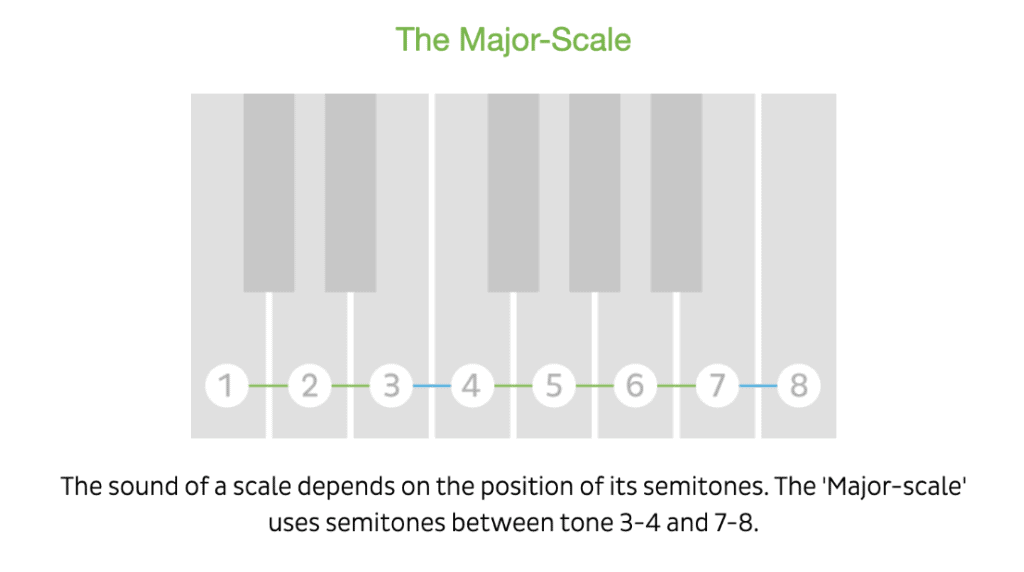
Minor scales
There are three main different types of minor scales: natural, harmonic and melodic.
While major scales sound quite happy, minor scales sound mysterious, sad, or exotic. They are often used to express more complex emotions. The construction of a natural minor scale looks like this:
A natural minor scale
A, B, C, D, E, F, G, A
Tonic – Tone – Semitone – Tone – Tone – Semitone – Tone – Tone
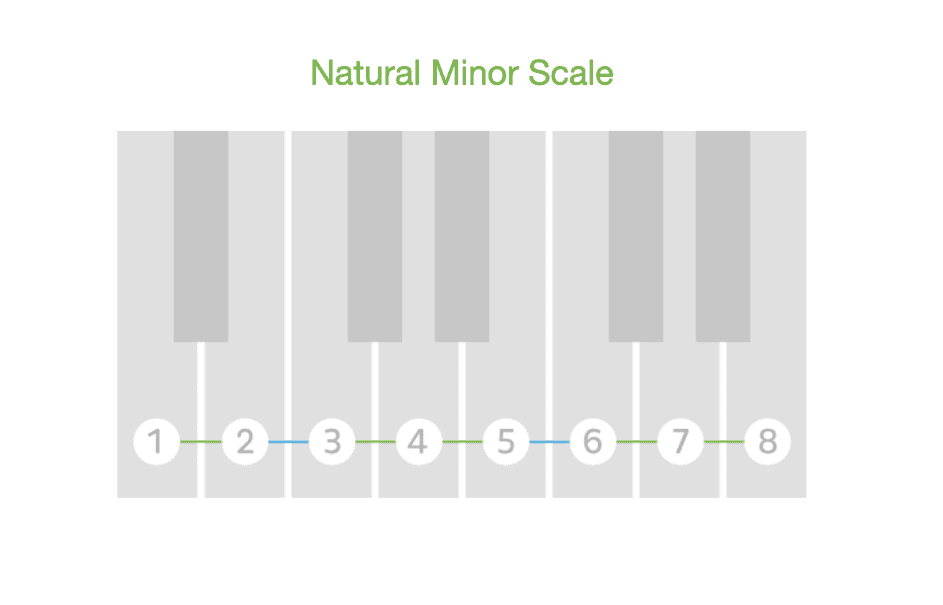
This scale uses the same fingering pattern as the C-major scale above. “Mad World” by Tears For Fears introduces the A minor scale. Learn the A-minor scale in the related Skoove lesson. Skoove will give you guidance and instant feedback on your playing.
The natural minor scale is also called ‘aeolian’ scale. The semitones are between note 2-3 and 5-6.
Have a look at Fallin’ and the E-natural minor scale to learn more about this type of scale and experience the impact that the minor key has on the character of the music. It perfectly echoes the confused emotions:
“Sometimes I feel good
At times I feel used
Lovin’ you darlin’
Makes me so confused”
The Harmonic Minor Scale
The harmonic scale is notable for its raised 7th note which does not appear in the key signature. This raised 7th means there is an interval of 3 semitones between the 6th and 7th note. This is the most commonly used minor scale in western music. The construction looks like this:
Tonic – Tone – Semitone -Tone – Tone – Semitone – 3 semitones – Semitone
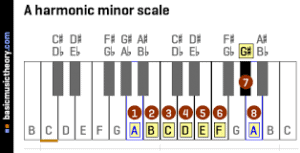
(Diagram courtesy of basicmusictheory.com)
The Melodic Minor Scale
To create a “melodic minor” scale, you still flatten the third note of the scale, but you raise both the 6th and 7th notes by a semitone going up. Coming down, you flatten both the 6th and 7th notes, so the scale is very different going up from coming down.
Ascending: Tonic – Tone – Semitone – Tone – Tone – Tone – Tone – Semitone
Descending: Tonic – Tone – Tone – Semitone – Tone – Tone – Semitone – Tone
There’s an easy way to remember the pattern, however. Ascending melodic minor scales turn into the major scale once you’ve passed the flatten third. Descending, the notes are exactly what the key signature is. For instance, A melodic minor has F# and G# going up (just as the A major scale does) and is all white notes coming down (just like the key signature of no sharps or flats!). Thinking of the melodic minor scale this way makes it much easier to remember.
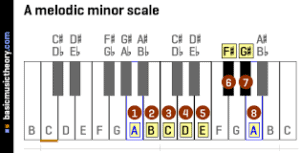
(Diagram courtesy of basicmusictheory.com)
To get a good sense of this scale, try inventing your own music using the intervals as shown above.
Contrary Motion Scales
Contrary – meaning opposite – and motion – meaning movement. These are scales that move in opposite directions and are fun to play. Certain keys are really challenging to play in this way, but give you the next level of skill if you practice them!
C major is the easiest one to play. To play a contrary motion scale in C major, start with both your thumbs on middle C. Your left hand is going to perform a descending scale while your right hand is going to perform an ascending scale, at the same time! You should find this quite easy to do. When you reach finger number 3 on E in the right hand and on A in the left hand, both your thumbs tuck under at the same time and land on F in the right hand and G in the left hand. Then you continue walking in opposite directions until you reach C in both hands with the little finger. Then reverse direction. 3rd fingers cross over the thumbs at the same moment on A in the left and E in the right. You should end up with both thumbs on middle C again. You can practice this in one octave until it’s smooth and secure, then try for two octaves. Like other scales, you can practice this scale in rhythms and various numbers of octaves.
When you’ve got C major going well, you can try the scale of G. G major is slightly more challenging because the F# comes at different moments in each hand.
The Major Pentatonic Scale
Another very commonly used scale in blues, jazz and even popular music is the Pentatonic scale. It’s a shorter scale, consisting of 6 notes, (if you double the root note at the top), and it has a major and minor variation. The major pentatonic is structured like this:
Tonic – Tone – Tone – 3 x Semitones – Tone – 3 x Semitones
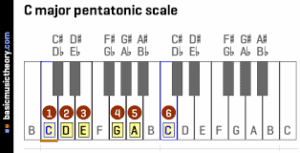
(Diagram courtesy of basicmusictheory.com)
The Minor Pentatonic Scale
The minor pentatonic is structured like this:
Tonic – 3 x Semitones – Tone – Tone – 3 x Semitones – Tone
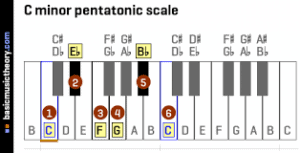
(Diagram courtesy of basicmusictheory.com)
Learn the difference between the Minor Pentatonic and the Blues Scale.
Blues Scales
The blues scale has a very distinctive sound. Get to know the magic of Blues & Boogie Woogie in this course. You can even do your first blues improvisation in this lesson.
The pattern of tones and semitones is this:
Tonic – 3 x Semitone – Tone – Semitone – Semitone – 3 x Semitone – Tone
By following this pattern, you can play the blues scale starting on any piano key.
Whole Tone Scales
This type of scale sounds rather “ethereal” and romantic. Claude Debussy used this scale frequently in his music. Listen to “La Mer” arranged for two pianos to get the sense of wonder that this scale conjures.
The construction is just as its name implies:
Tonic – Tone – Tone – Tone – Tone – Tone – Tone
Watch a tutorial for whole tone scales here
The link between scales and chords
You can build a chord from any scale by using the 1st, 3rd and 5th notes. If you take notes 1, 3, 5 from a C major scale, you’ll have a C major chord. If you take the same notes from an E minor scale, you’ll have an E minor chord.
If you’re just starting out learning chords, practice some basic chords first before progressing on.
As well as building up your knowledge and skill of scales, work up your “toolkit” of chords as this will help you to play chord progressions and ultimately, any song you like!
Practice chords in a fun way – play around with loads of chords to absorb how they work.
Piano Scales Generator
This piano scales generator from Pianoworld is handy tool to learn scales. It is interactive and easy to use.
If you are reading this from a mobile device, rotate it to display the tool in full width.
1. Click on “Scale”
2. Choose the “Root” of the scale
2. Choose the “Type” (major, minor, etc.)
3. Click “Display”
* You can do the same with chords.
** You can invert chords and scales
*** You can have scales cover the entire keyboard
Final words
Anyone can make up a scale, if you are feeling experimental, why not have a go? It is an interesting way to see the impact of a scale and key on the character of the music. Playing the major, minor and blues scales while considering the benefits above will maximize your learning potential. Enjoy exploring these musical patterns.
Author of this blog post:

Roberta Wolff started piano lessons at the age of five and is still enjoying learning! Currently, she teaches piano pedagogy and performance pedagogy at post graduate level in the UK. Her other work includes running a private teaching practice for students of all ages and abilities and creating learning and practice resources. Roberta loves writing as a means to supporting others on their piano journey.

